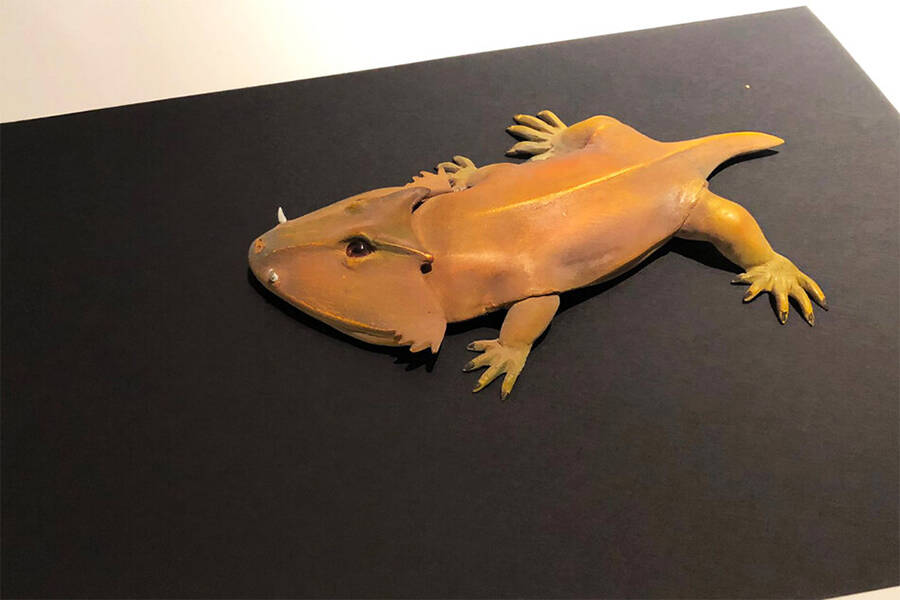Chemnitzion richteri was discovered at the site of an ancient petrified forest and is believed to have roamed the Earth 291 million years ago.

Calliesauria, Museum of Natural History Chemnitz 2022/ZengerA 3D render of Chemnitzion richteri, the amphibian believed to have lived nearly 300 million years ago.
Given how old the Earth is and how recent the field of science is comparatively, much remains unknown about the planet’s zoological history. Modern researchers regularly find fossils that provide evidence to support the existence of previously-undiscovered creatures, and now German scientists have identified the remains of a unique, extinct amphibian species.
As reported by The Florida Star, the species, known as Chemnitzion richteri, was discovered “at Frankenberger Road in Chemnitz-Hilbersdorf, right where the local fire station is situated today,” said Chemnitz city official Ralph Burghart.
The site of what is now the fire station was once the location of a petrified forest, and the ancient amphibian species inhabited the area around 291 million years ago. Researchers consider the petrified forest one of the region’s most important archaeological sites, and local news media lauded the discovery as a “paleontologic sensation.”
The team that made the historic discovery was composed of scientists and researchers from Chemnitz, Freiberg, Schleusingen, and Berlin.

Bernd RippertA 3D model of Chemnitzion richteri will soon be on display at the Chemnitz Natural History Museum.
Experts from the Chemnitz Natural History Museum and the University of Technology Freiberg said that the ancient German species had short legs and an extra large head, describing it as an “insectivore.”
“It was capable of powerfully projecting its large sticky tongue from its mouth to capture insects and articulate animals,” said the museum’s curator, Thorid Zierold. Researchers have classified it as a member of the amphibian group “Labyrinthodontia,” an ancient Greek word meaning “maze-toothed.”
Chemnitzion richteri used an ambush strategy to feed on ancient insects and other arthropods, researchers said, and prospered towards the end of the Paleozoic era and the beginning of the Mesozoic era.
The Paleozoic era marked a significant shakeup in Earth’s topography as continents shifted and the planet’s climate went through major changes. According to Live Science, the evolution of life on Earth during this period coincided with a period of incredibly warm weather followed by a long ice age. Around this time, Earth was ruled primarily by marine invertebrates — most famously, the trilobite.

Bundesarchiv Bild/Wikimedia CommonsThe remains of the petrified forest in Chemnitz, Germany as seen in 1964.
Later Paleozoic periods saw the rise of terrestrial life, notably ferns, the first trees, and tetrapods, widely diverse creatures ranging from lizard-like to snake-like in appearance. Alongside tetrapods, Earth was introduced to its first land-living arthropods, the ancient ancestors of spiders.
Tetrapods and arthropods began to dominate the landmasses of Earth, and over the course of millions of years, gradual evolutionary changes saw more diverse species emerge, including Chemnitzion richteri.
The Mesozoic era occurred just after the Paleozoic era and means “middle life,” according to the United States Geological Survey. Also known as “the age of conifers,” the Mesozoic era was ruled predominantly by the dinosaurs and includes the Triassic, Jurassic, and Cretaceous Periods. Alongside these giant creatures, the planet saw massive, blossoming flora across the surface.
If researchers’ estimates are correct, then Chemnitzion richteri would have co-existed with many of the popular dinosaurs featured in films and on television.
Furthermore, while Chemnitzion richteri may seem similar to other amphibian species, scientists have stressed that its general build is drastically different from other insectivore amphibians. As a result, researchers decided to classify it as its own species, honoring its discovery in Chemnitz in the first part of its name — Chemnitzion — and paying tribute to revered local researcher Fred Richter in the second half of its name, richteri.
Ronny Roessler, director of the Chemnitz Natural History Museum, informed the press that a 3D model of Chemnitzion richteri will soon be going on display.
After reading about the new amphibian discovered by German researchers, check out the Madagascan moth species with the longest tongue of any insect. Or, read about the ancient giant sloth species that ate meat.





